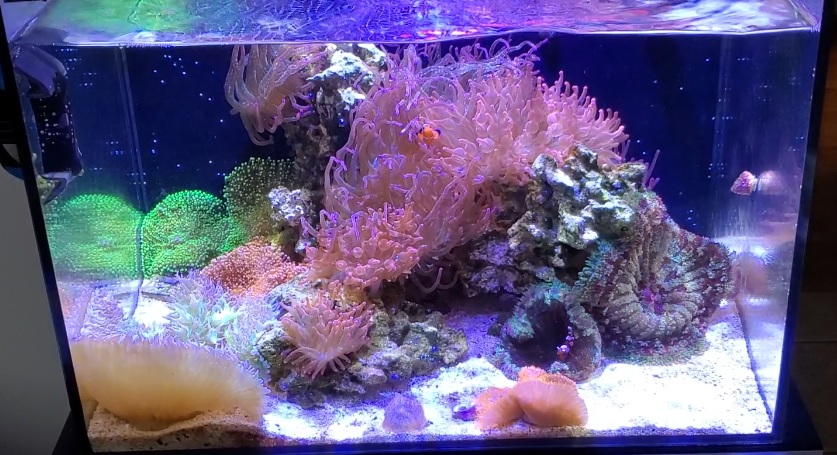
In many of my prior articles I always brought up the “6 P’s – Prior Proper Planning Prevents Poor Performance“. In reality this mentality can be applied to everything in life. With regards to our beloved hobby the planning process involves many aspects as well. Many beginners jump into the hobby as an emotional purchase without prior research. Most readers of this forum are not novices anymore, but if you can help mentor or even communicate the proper practices we have evolved we can deter the failures and build a more sustainable hobbyist base. Remember we are dealing with living organisms, and their health and well-being are our priority and responsibility.
Goals vs Constraints
Goals should always come first. Why are you doing this? What are you trying to achieve? Do you plan on expanding? These requirements should be measurable so you can tell if you actually achieved it. The initial step that many people miss is defining realistic goals. The goals you set directly impact the long term success of the system, from the livestock choices, the applicable hardware purchased, and the level of maintenance to sustain it.
Constraints go hand in hand with goals in the early stages of planning. Constraints act as limiting factors that determine the scope of the project. It is important to understand both criteria since they directly impact the scale and resources needed for the system.
A basic list of constraints can include the following.
- Time (“Level of Effort”)
- Facilities (location, space, utilities availability, etc.)
- Budget
- Knowledge/ Experience
- Livestock Availability
How you prioritize your goals and constraints will also impact design choices. Most people usually just bring up aesthetics (a tank they want to emulate) as their goal but often neglect the “Level of Effort” they are willing to put into sustaining the system. “Level of Effort” touches many aspects in the choices you will have to make. In this discussion let us focus on minimal “Level of Effort” as the priority.
Level of Effort
“Level of Effort” is clearly a component of the “time” constraint. Once all the Goals and Constraints are listed they should be simultaneously reviewed to determine the direction of the system design. The aspect of time could be broken up between the Design Stage, Build Stage, and Sustaining Stage. Relatively speaking, a long term view of having the system up and running for multiple years should be the norm. If this is not your first rodeo you may also plan for expansion up front since “Multi-Tank Syndrome” is a real thing in this hobby. I myself am a victim of it.
Personal System Comparison
During the design stage “Level of Effort” will impact the live stock choices first. For example, a scale of effort can be rated from low to high as Fish Only, Soft Corals, Large Polyp Stony Corals, and Small Polyp Stony Corals. This is primarily due to understanding the requirements needed to sustain them. Obviously there are varying gradients of hardiness within each category as well. The livestock choice will also impact the exposure to factors such as growth size, feeding, compatibility, parasites, diseases, etc. So if you chose a Mixed Reef as a goal you will have many more things to balance as compared to a focused few hardy specimens tank.
To illustrate the extreme differences here are two completely separate systems that I consider to be on the extreme spectrums. My personal goals were to reduce the “Level of Effort” during the maintenance stage of my newest nano tank. My oldest system is currently 17 years old and easily shows when things are implemented outside of the original setup.
Main 7 Tank System (~510 gallons)
My main system is geared primarily for stony corals. It is highly automated with some built in redundancy. Over the years I have found it too much of a hassle to maintain multiple individual systems in this house. A “Mixed Reef” system is definitely more challenging from my experience. I decided to dedicate tanks to similar livestock with specific requirements for more success. Stony corals tend to have the most stringent requirements with respect to lighting, flow, and water chemistry. To maintain a stable environment it requires more control to minimize deviations. I used to travel for work a lot and lived in a hotel ~190 days/year for over 12 years. High levels of automation was a must in this case. But even with automation and redundancy it has become quite complex over the years where it is no substitute for direct interaction.
Pros:
- Water chemistry stability by volume – more room for error
- Single source automated water change system for all 7 tanks
- Consolidation of equipment for multiple tanks
- Easy relocation of livestock to find the correct environment
- Focused configurations of lighting, flow and nutrient levels per livestock requirements (Great for experimentation)
- Ability to isolate the 7 tanks into 4 subsystems if necessary
- Remote monitoring and control
Cons:
- Very large water changes are needed if issues occur
- Very large treatment doses are necessary to treat anything
- Difficult to isolate diseases or pests once it gets in
- Not a clean setup to look at due to unplanned additions over time that impact serviceability
- Automated Testing is great when they work but all equipment requires a lot of maintenance/troubleshooting to keep them working properly.
- Since equipment was incrementally added on with limited space it does not look pretty
My case of “Multi-Tank Syndrome” created additional service challenges since the additions were not in the original design plan. So take heed that this is an NOT an example of a clean system design but a perfect example of “Creeping Elegance” to achieve “Fit, Form, and Function” that has been running for 17 years. It would take a system crash or winning the lottery to justify re-designing the entire system.
Creeping Elegance
- 3 sumps (Redundant Fleece Filters, Media Reactors, Ozone )
- 2 Controller environments (Neptune Apex Classic, CoralVue Hydros)
- Multiple Supplementation Devices – (Calcium Reactor, Kalkwasser dosing, and 2 Part Dosing, Manual DIY Trace Element Dosing)
- Multiple Automated Water Parameter Testing devices (Reef Kinetics ReefBot V1, Dr. Bridge KH Guardian V1, monthly ICP Testing)
- A rat’s nest of wiring built over time from all the components used
Below are some of my favorite tank shots over the years since I have to re-scape every 5-8 years due to overgrowth or issues that arise.
- Front View
- 125g before latest 2023 ReScape
- 120g after Re-Scape in 2017
- Fish Room Rear View
- 80g Frag Tank and 40Breeder
- 12g LPS Bookshelf
- 50g Low Boy during Tridacna Clam Addiction
- Fluval EVO 13.5 V1
Tank # 8 – My Newest and Simplest System
The simplest system I have is a Reef Casa Studio 12 that is dedicated to anemones and mushrooms. It is completely isolated from my main system and was specifically designed to be low maintenance with no dosing required other than occasional water changes. The lighting, flow, and water parameters are within the range of what bubble-tip anemones (Entacmaea quadricolor) and the various Discosoma and Rhodactis mushroom anemones require. The 4 nano fish (2 Oscellaris clowns, Starry Blenny, and Neon Goby) and various invertebrates (snails, sexy shrimp, emerald crabs) are secondary to provide some utilitarian functions and movement. This has turned into my most enjoyable tank since it requires the least interaction yet provides a beautiful centerpiece as you walk into the house.
Only additional items I added to the AIO tank kit:
- Landen Stand
- Skimmer
- Hydros Control 2 setup for Auto Top Off and Component Control
- UV Bulb in Return Chamber (Helps with reducing algae on the glass since this is exposed to some sunlight)

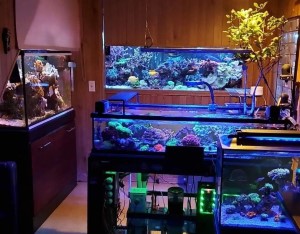
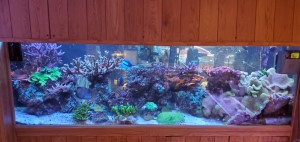
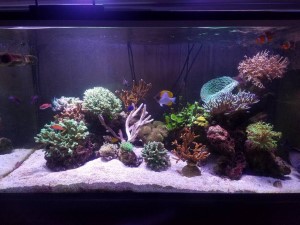
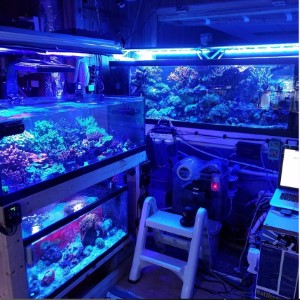
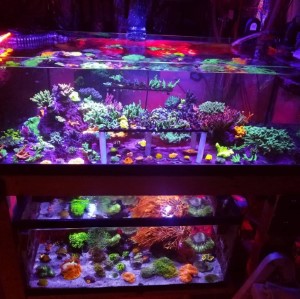
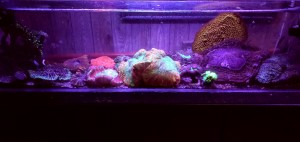
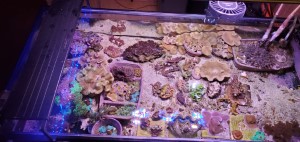
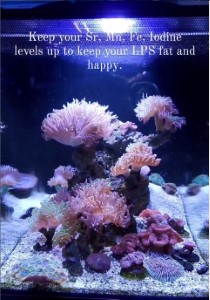









0 Comments